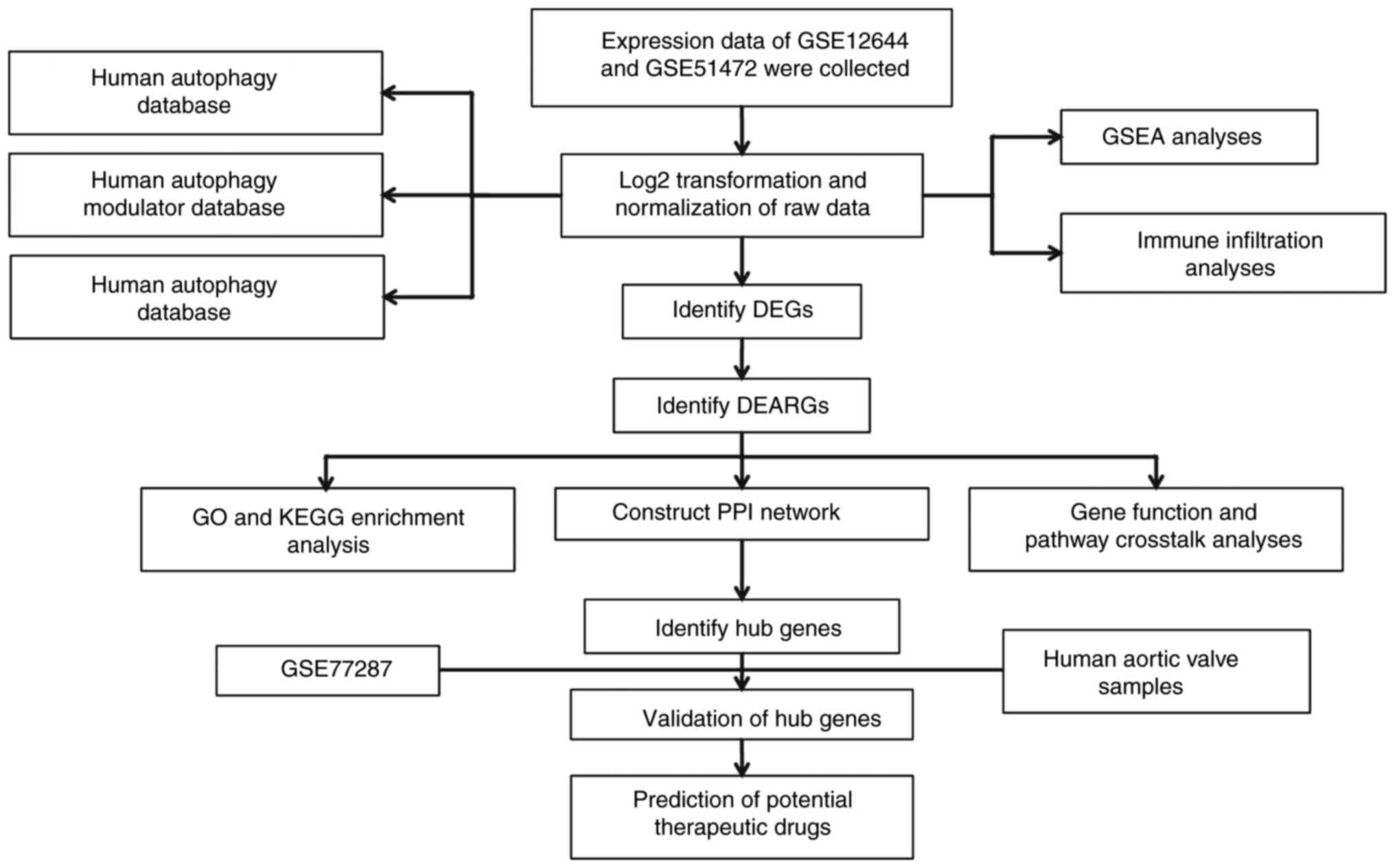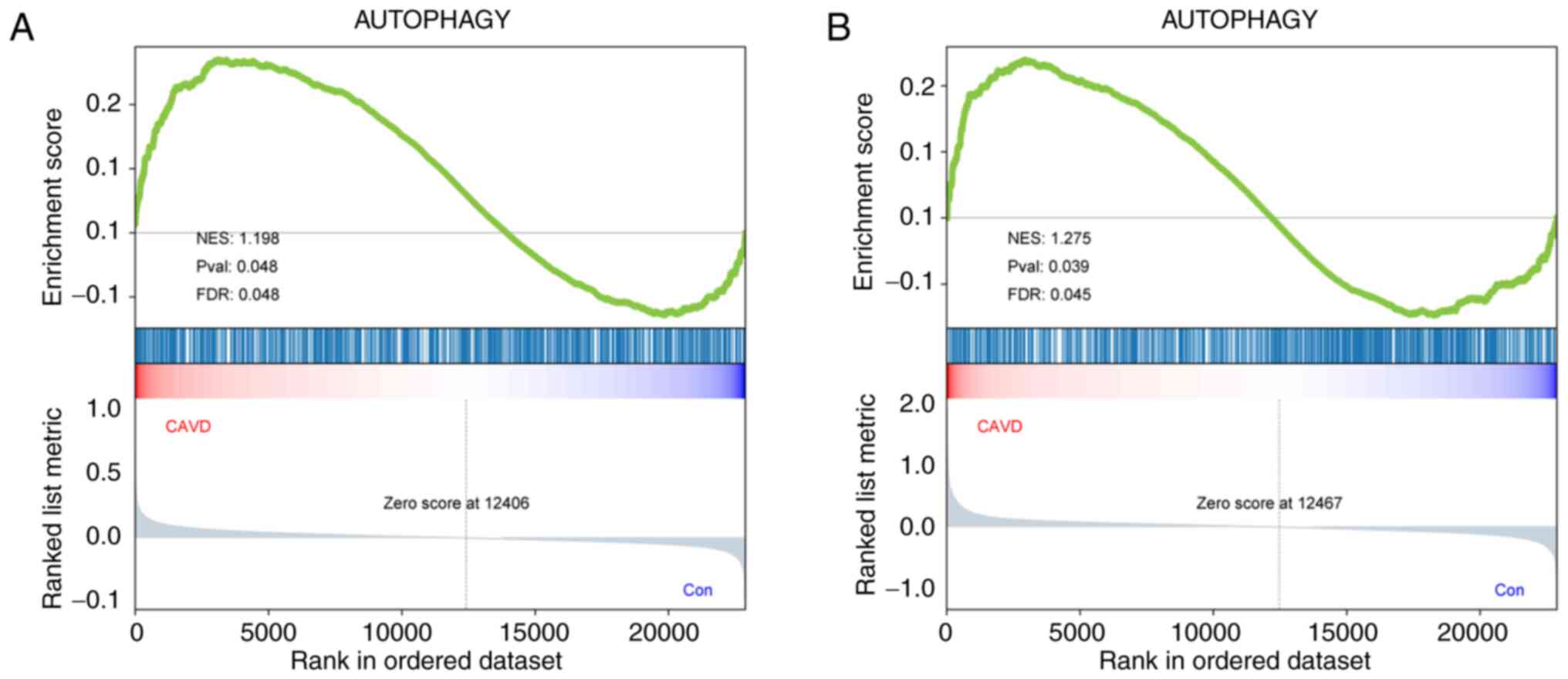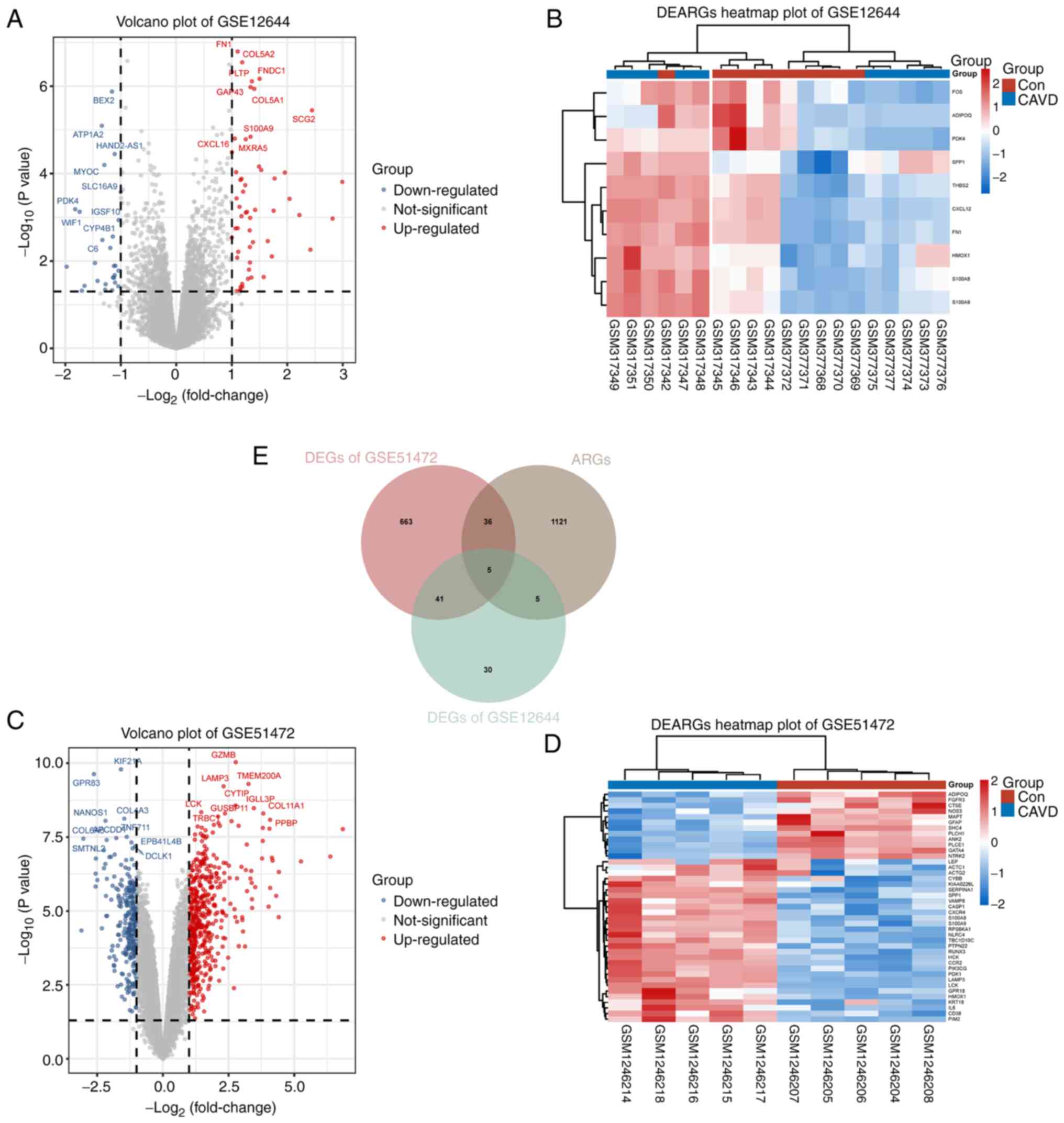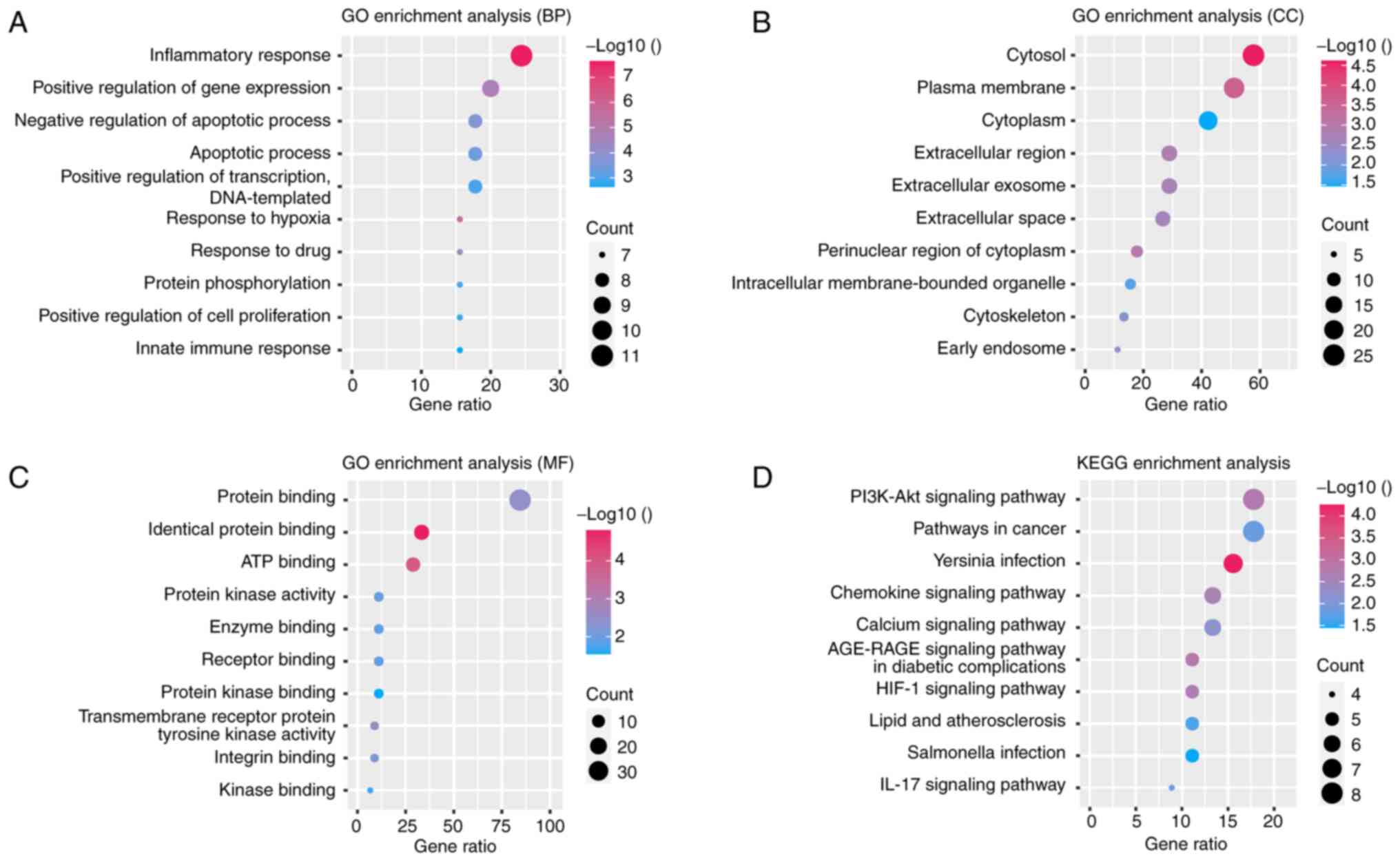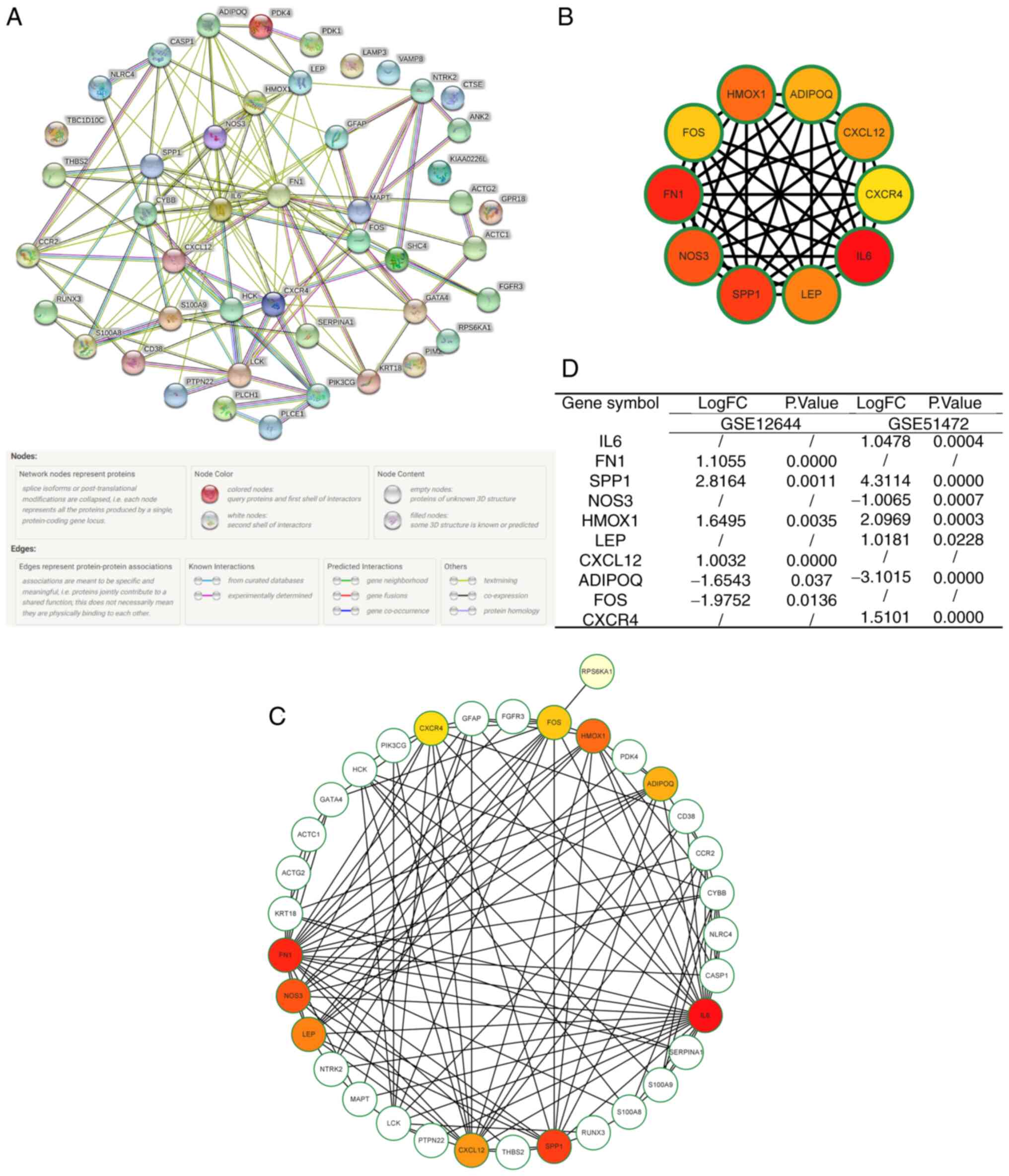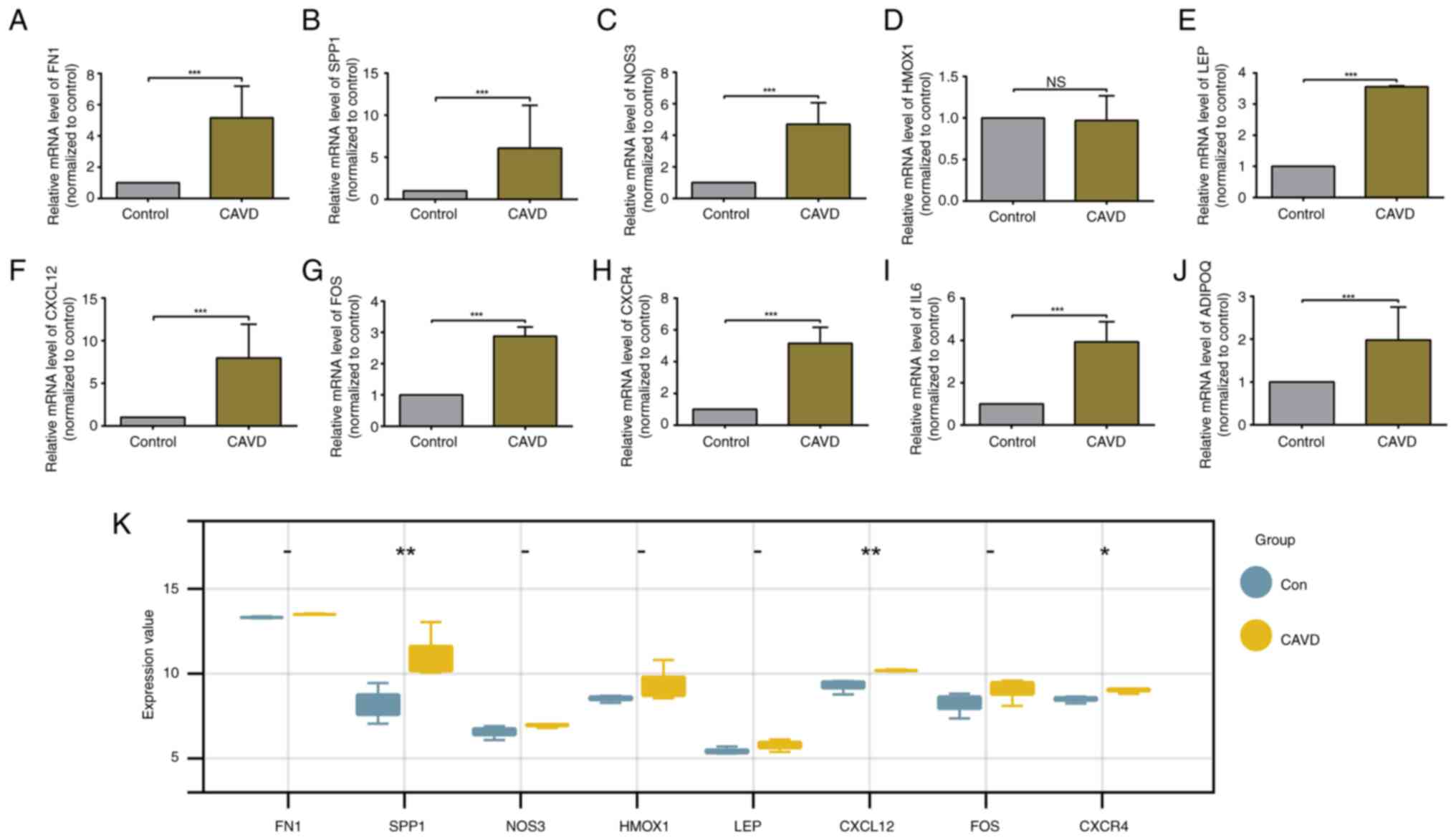Investigation of autophagy‑related genes and immune infiltration in calcific aortic valve disease: A bioinformatics analysis and experimental validation
- Authors:
- Published online on: March 26, 2024 https://doi.org/10.3892/etm.2024.12521
- Article Number: 233
-
Copyright: © Hu et al. This is an open access article distributed under the terms of Creative Commons Attribution License.
Abstract
Introduction
Calcific aortic valve disease (CAVD) is the most common cardiovascular disease (1). As longevity increases and lifestyles adapt, the incidence of CAVD has risen notably, which could lead to aortic stenosis and heart failure (2). Currently, early surgery remains the most effective approach for improving the prognosis of patients with CAVD. Previous studies have revealed that the pathological process of CAVD is complex and is associated with multiple factors, including lipoprotein deposition, inflammatory response and calcific nodule formation (3,4). Therefore, it is necessary to further understand the pathological process of CAVD and discover its unique biomarkers and potential therapeutic pathways to improve the prognosis of patients with CAVD. Autophagy, a cellular process that maintains homeostasis via degrading and recycling proteins and organelles in lysosomes, is involved in various cellular functions, including metabolic regulation, immune response, apoptosis and differentiation (5-8). This biological process is involved in multiple diseases, including neurodegenerative diseases (9), cancer (10), cardiovascular diseases (11) and metabolic disorders (12). Autophagy serves as a ‘regulator’ that maintains cardiovascular redox homeostasis and preserves cardiovascular functionality via the complex relationship between oxidant-dependent signaling and autophagic flux. Peng et al (13) have reported that atorvastatin bolsters vulnerable atherosclerotic plaque stability and diminishes aortic lesion sizes by amplifying autophagy, which in turn mitigates inflammatory cytokine secretion and lipid accumulation. Similarly, spermidine, an endogenous, naturally occurring polyamine, significantly reduces necrotic core areas and lipid accumulation by inducing autophagy to stimulate cholesterol efflux from vascular smooth muscle cells (VSMCs) (14). These autophagy-driven effects underscore the potential of autophagy induction in cardiovascular disease prevention (15). Additionally, research has demonstrated that in instances of chronic heart failure following myocardial infarction, increased levels of matrix metalloproteinase 9 (MMP9) can suppress cardiac autophagic activity, subsequently exacerbating myocardial ischemia-induced chronic heart failure (16). Furthermore, according to Wang et al (17), protein kinase AMP-activated catalytic subunit α2 (AMPKα2) overexpression in mouse hearts could blunt the progression of chronic heart failure by amplifying mitochondrial autophagy and improving mitochondrial functionality. These studies collectively illustrate the profound influence of autophagy on cardiovascular health and disease progression.
Interestingly, previous studies have highlighted the key role of the RNA-binding protein Sam68 in driving human valve interstitial cell osteogenic differentiation via the STAT3 signaling pathway and autophagic flux regulation (18). In addition, autophagy upregulation has been observed in the calcified tissues of patients, showing that autophagy plays compensatory and pro-survival roles in this disease (19). Overall, this compelling evidence emphasizes the promising potential for identifying autophagy-related targets as therapeutic approaches for CAVD.
In the present study, a multifaceted approach to explore the molecular mechanism involved in autophagy in CAVD was utilized. Microarray data were collected and analyzed to identify autophagy-related genes, and further enrichment analyses were conducted to understand their roles and interactions. Key genes were verified using an independent dataset and quantitative reverse-transcription quantitative PCR (RT-qPCR) analyses of patient samples, and their potential as drug targets was examined. Finally, immune infiltration in response to CAVD was studied to understand its role in disease progression.
Materials and methods
Microarray data collection
A total of three microarray datasets GSE12644 (10 control and 10 CAVD samples) (20), GSE51472 (5 control and 5 CAVD samples) (21) and GSE77287 (3 control and 3 CAVD samples) were obtained from the Gene Expression Omnibus (GEO) database (https://www.ncbi.nlm.nih.gov/geo/) (22). Then, mRNA expression profiles (GSE12644 and GSE51472) were applied to screen for differentially expressed genes (DEGs) and differentially expressed autophagy-related genes (DEARGs); GSE77287 was used for validation of hub genes. When multiple probes corresponded to a gene, the average expression value was used as the gene expression value after the probe IDs were converted into gene symbols. The microarray data from 3 datasets were normalized and log2 transformed.
DEG and DEARG identification
The limma package (version 3.48.1) in R software (version 4.1; https://www.R-project.org/) was used to identify DEGs between normal and CAVD samples; thresholds of |log2FC|≥1 and P<0.05 were adjusted by the Benjamini and Hochberg method. In addition, autophagy-related genes (ARGs) were extracted from three widely used autophagy-related databases: The Human Autophagy Modulator Database (http://hamdb.scbdd.com) (23), the Human Autophagy Database (http://www.autophagy.lu/index.html) (24), and the Autophagy Database (http://www.tanpaku.org/autophagy/index.html) (25). Ultimately, 1167 ARGs were obtained after the deduplication of genes, and these are listed in Table SI. Overlapping target DEARGs between the DEGs and ARGs were identified by using the VennDiagram package (version 1.6.19) in R software (26).
Gene set enrichment analysis (GSEA)
As a computational method for interpreting gene expression data based on a molecular signature database, GSEA was performed using GSEA software (http://software.broadinstitute.org/gsea/index.jsp) to explore the overall relationship between ARGs and CAVD. The ARG set contained 1,167 ARGs, and the core genes and enrichment score (ES) were calculated using the score and rank of genes in GSE12644 and GSE51472. In addition, |NES|>1.0 and normal P<0.05 were considered significant in the present study.
Gene Ontology (GO) and Kyoto Encyclopedia of Genes and Genomes (KEGG) enrichment analysis of DEARGs
GO and KEGG analyses were performed with the DEARGs identified from GSE12644 and GSE51472 by using the Database for Annotation, Visualization and Integrated Discovery (DAVID) (http://david.ncifcrf.gov/) to explore the biological characteristics and signaling pathway related to DEARGs. A P<0.05 was applied as the cutoff criterion.
Construction of a protein-protein interaction (PPI) network and identification of hub genes and key modules
In the present study, the STRING (27) database (http://string-db.org/) and Cytoscape software (version 3.8.2; https://cytoscape.org/) were used to construct and visualize a PPI network of DEARGs. The hub genes were screened using Cytohubba, a Cytoscape plugin based on the MCC algorithm (16). Each DEARG in the PPI network was assigned a value, and the genes were ranked accordingly. The top 10 genes were identified as hub genes.
Validation of hub genes in GSE77287
The independent microarray dataset GSE77287 was utilized to validate the hub genes. After ID conversion with the data normalized and log2 transformed, the expression values of 10 hub genes were obtained and compared between normal and CAVD groups using the Wilcoxon test. Results with P<0.05 were considered statistically significant.
Immune infiltration analyses
To explore the relationship between the immune response and CAVD, normalized gene expression data from GSE12644 and GSE51472 were entered in HiPlot software (version 0.1.2; http://hiplot.com.cn/). The CIBERSORT algorithm was used to calculate the proportion of infiltrating immune cells, and a t-test was used to compare between normal and CAVD groups. Results with P<0.05 were considered statistically significant.
Potential drug prediction of hub genes
The DsigDB (28) database (http://dsigdb.tanlab.org/), which contains >20,000 gene sets and 17,389 unique compounds covering 19,531 genes, was used to examine potential target drugs associated with the hub genes by comparing the differences in gene expression between control and drug-treated groups included in DSigDB database using the unpaired two-tailed Student's t-test. An FDR<0.05 and a combined score >2x106 were used as the thresholds for potential drug selection.
RT-qPCR
In the present study, aortic valves gathered from 3 patients with CAVD were considered the CAVD group, whereas aortic valves harvested from 3 patients with acute aortic dissection without calcification were considered the control group. All of the aortic valves were collected by surgery. The six adult patients (4 men and 2 women, all aged between 41-62 years) included in the present study had undergone valvular surgery or acute aortic dissection repair surgery between September 2022 and May 2023 in the Second Affiliated Hospital of Nanchang University (Nanchang, China). Patients with any of the following comorbidities were not be involved in the present study: i) Serious coronary heart disease, heart tumor, congenital heart disease, or infective endocarditis; ii) thyroid disease; iii) organ failure, cancer, infection or autoimmune disease; iv) serious psychiatric or neurological illness. Detailed information on patients involved in the present study is listed in Table SII. Total RNA was extracted from the aortic valve tissues using TRIzol® reagent (Invitrogen; Thermo Fisher Scientific, Inc.) and reverse transcribed into cDNA using RevertAid MM (Thermo Fisher Scientific, Inc.) after the RNA quality and yield were evaluated. The ratio of 260/280 nm, which reflects RNA quality, was required to be 1.8-2.0. RT was conducted as follows: 42˚C for 1 h, then 72˚C for 10 min. A Light Cycler 480 Real-Time PCR system (Roche Diagnostics) and TB Green Premix Ex Taq (Takara Bio, Inc.) were used to identify gene expression levels. The qPCR process consisted of denaturation at 98˚C for 2 min, accompanied by thermocycling at 98˚C for 10 sec, 60˚C for 15 sec, and 68˚C for 1 min, repeated for 40 cycles. ACTB was used as an internal control to normalize relative expressions of mRNA using the 2-ΔΔCq method (29). The sequences of the primers (Sangon Biotech Co., Ltd.) used are included in Table SIII. Written formal consent was acquired from all patients, and the present study was approved (approval no. SYXK2021-0073) by the Ethics Committee of the Second Affiliated Hospital of Nanchang University (Nanchang, China). The experimental protocol was established according to the ethical guidelines of the Helsinki Declaration and its revision from October 2013.
Statistical analysis
The statistical analyses involved in the present study were conducted by the Sangerbox platform or GraphPad Prism 6.0 (Dotmatics) and data are expressed as the mean ± standard derivation (all experiments were repeated three times). In addition, comparisons between two groups were made using the unpaired two-tailed Student's t-test. P<0.05 was considered to indicate a statistically significant difference.
Results
Overall design of the study
The overall flowchart of the study is shown in Fig. 1.
Relationship between autophagy and CAVD
GSEA is a well-known, powerful analytical method for identifying pathways related to gene expression data. Therefore, a GSEA was conducted on an ARG dataset to explore the role of the autophagy pathway in the pathological process of CAVD. The ARG set was significantly enriched in the CAVD samples of both microarray datasets, with a nominal P<0.05 and |NES|>1.0; these ARGs were predominantly upregulated (Fig. 2A and B). This finding indicated a substantial and significant relationship between autophagy and CAVD. In addition, all 339 core genes in GSE12644 and GSE51472 were identified by GSEA.
DEG and DEARG identification
A total of 827 DEGs were identified from GSE12644 and GSE51472 using default thresholds (|log2FC|>1.0 and P<0.05) (Fig. 3A and C). These DEGs included 526 upregulated genes and 300 downregulated genes. Additionally, after obtaining 1,167 ARGs from multiple databases, 46 DEARGs were identified for further analysis by overlapping the ARGs with the DEGs from GSE12644 and GSE51472 (Fig. 3E). The expression differences of these 46 DEARGs in normal and CAVD groups were visualized in a clustered heatmap using the Ward.D2 algorithm (Fig. 3B and D). These results indicated that the DEARGs that were screened out may play a crucial role in CAVD development by regulating autophagy.
GO and KEGG pathway enrichment analysis
GO and KEGG pathway enrichment analyses were conducted to further understand the functions and related pathways of the DEARGs. As shown in Fig. 4A-D, the GO enrichment analysis indicated that DEARGs in the biological process category were enriched primarily in the inflammatory response, positive regulation of gene expression and negative regulation of apoptotic processes. In the cellular component category, the DEARGs were enriched mainly in the cytosol, plasma membrane and cytoplasm. For the molecular function category, protein binding, identical protein binding and ATP binding were predominantly enriched. KEGG pathway analysis results revealed that the DEARGs participated mainly in the PI3K-Akt signaling pathway, pathways in cancer and Yersinia infection. Furthermore, the interaction between genes and different functions or pathways was explored. As demonstrated in Fig. 5A-D, the role of the DEARGs in CAVD regulation is complex and involves multiple gene functions and pathways. Through both GO and KEGG pathway enrichment analyses, it is evident that the role of DEARGs in CAVD regulation is intricate, encompassing various gene functions and pathways.
Construction of a PPI network and identification of hub genes and key modules
A PPI network was constructed to further investigate the interactions of the DEARGs by the STRING database (Fig. 6A). Additionally, Cytoscape software was utilized to quantify the data. Based on the MCC algorithm, the top 10 genes were identified: IL6, FN1, SPP1, NOS3, HMOX1, LEP, CXCL12, ADIPOQ, FOS and CXCR4 (Fig. 6B and C). Moreover, the numerous relationships between the hub genes and other DEARGs are visualized in Fig. 6D.
Validation of hub gene expression in calcified aortic valve samples
In the present study, the expression levels of hub genes in control and CAVD groups were validated. As revealed in Fig. 7A-J, the RT-qPCR results suggested that the hub genes, except for HMOX1, were significantly upregulated in the calcified aortic valve samples; these particular genes were thus identified as key genes. The aforementioned results indicated that the hub genes that were screened out may participate in the development of CAVD by regulating autophagy.
Validation of hub gene expression
Another independent dataset, GSE77287, was chosen to validate the key genes. Upon pre-processing the data extracted from GSE77287, expression data for the 9 key genes were analysed. Three of the nine selected hub genes (SPP1, CXCL12 and CXCR4) were remarkably upregulated in CAVD samples, which is consistent with the GSE12644 and GSE51472 results (Fig. 7K).
Immune infiltration analyses
Recently, an association between the immune response and CAVD occurrence has been demonstrated (30). An immune infiltration analysis using CAVD samples to further understand the interaction between DEARGs and the immune response was consequently performed. As demonstrated in Fig. 8A and B, the CIBERSORT algorithm was used to evaluate the proportions of 22 immune cell types in the aortic valve samples from GSE12644 and GSE51472. Further statistical analyses indicated that activated NK cells were significantly upregulated in the normal aortic valve samples of both datasets, while M0 macrophages were significantly downregulated in both datasets (Fig. 8C and D). Additionally, there were significant differences in the infiltration scores of normal and calcified aortic valve samples calculated by ssGSEA for both datasets, GSE51472 (P<0.05) and GSE12644 (P<0.05), suggesting that immune infiltration plays a significant role in the pathological process of CAVD. Further research is needed to investigate the regulatory effects of DEARGs on immune infiltration in CAVD.
Prediction of potential therapeutic drugs
The DSigDB database was employed to predict potential therapeutic drugs related to the hub genes. This important database includes detailed drug data and comprehensive information on drug targets and drug actions. A total of 1,599 potential autophagy-related drugs were ultimately identified and ranked by their combined score. The top 10 predicted drugs are displayed in Fig. 9A. The top four drugs, which exhibited strong drug-target associations (adjusted P<0.0001, combined score >2x106) are as follows: bisphenol A (Fig. 9B, combined score=5,183,719.14), resveratrol (Fig. 9C, combined score=4,650,762.31), progesterone (Fig. 9D, combined score=4,246,664.85) and estradiol (Fig. 9E, combined score=156640) (Fig. 9F).
Discussion
The present explored the role of autophagy in the pathological process of CAVD. The main findings are as follows: i) The GSEA revealed a significant relationship between autophagy and CAVD, with upregulated ARGs observed in CAVD samples; ii) GO and KEGG pathway analyses shed light on the functional roles of DEARGs, including their involvement in the inflammatory response, gene regulation and apoptotic processes, as well as their participation in signaling pathways such as PI3K-Akt and pathways in cancer; iii) the construction of a PPI network identified hub genes, including IL6, FN1, SPP1, NOS3, HMOX1, LEP, CXCL12, ADIPOQ, FOS and CXCR4, which play crucial roles in CAVD progression by regulating autophagy. The expression of these hub genes was validated in another dataset and calcified aortic valve tissues; iv) furthermore, immune infiltration analysis highlighted the involvement of immune cells, such as activated NK cells and macrophages, in CAVD pathogenesis; and v) the present study also identified potential therapeutic drugs for CAVD that target autophagy-related hub genes, including bisphenol A, resveratrol, progesterone and estradiol.
It is very well established that valve calcification is a complicated biological process affected by multiple factors, including lipoprotein deposition, inflammatory responses, renin-angiotensin-aldosterone system activation, extracellular matrix remodelling and cytoskeleton changes. This multifactorial process leads to the destruction of valve-specific cells, such as endothelial and mesenchymal cells, which causes valve calcification, valve orifice stenosis and left ventricular outflow tract obstruction (31-33).
Although numerous of the factors contributing to valve calcification are understood, the role of autophagy within this process remains elusive (18,34). This significant research gap warrants further investigation. In the present study, in order to find genes related to autophagy in CAVD, bioinformatics techniques were leveraged. The aim of the present study was not only to enhance comprehension of the disease trajectory but also to pinpoint potential therapeutic candidates. The results of GSEA indicated a substantial and significant association between autophagy and CAVD. Notably, the DEARGs that were identified were mostly upregulated and might be crucial in the pathology of CAVD via autophagy mediation. These genes and their role in autophagy could be potential therapeutic targets or biomarkers for CAVD. The functional enrichment analyses, including GO and KEGG pathway analyses, provided a functional interpretation of the DEARGs. The significant enrichment of these genes in multiple biological processes and pathways, such as the inflammatory response, gene expression regulation, apoptotic processes, and, notably, the PI3K-Akt signaling pathway, underscores their roles in these crucial cellular functions. Autophagy plays an indispensable role in cellular health and regulates NLRP3 inflammasome activation. Inflammasome over-activation, due to autophagy impairment, can result in inflammatory diseases. Hence, balanced interactions between autophagy and inflammatory responses are paramount in preventing cellular damage and disease progression (35). Though distinct in nature, autophagy and apoptosis are intricately intertwined, collaboratively maintaining cellular and tissue homeostasis. Autophagy is tasked with the turnover of protein aggregates and damaged organelles, while apoptosis is responsible for eliminating redundant cells. The essential nature of caspases in this interplay cannot be overstated. They not only instigate apoptotic cell death but also shape autophagic responses by degrading autophagy proteins and converting pro-autophagic proteins into pro-apoptotic ones; these functions highlight the sophistication and significance of autophagy-apoptosis crosstalk (36). Interestingly, research has pointed to the potential therapeutic use of PI3K/AKT/mTOR signaling pathway modulation. In fact, previous studies have demonstrated that inhibiting this pathway can enhance autophagy activity in rat articular chondrocytes and mitigate inflammatory responses (37). This suggests a counterintuitive negative association between the PI3K/AKT signaling pathway and autophagy, revealing a new layer of complexity in these biological interactions.
To further identify the mechanism of autophagy activation in CAVD, a PPI network of DEARGs was established and several hub genes were identified, including IL6, FN1, SPP1, NOS3, HMOX1, LEP, CXCL12, ADIPOQ, FOS and CXCR4. The substantial connectivity of these genes in the PPI network implies their pivotal roles in the autophagy pathway and their potential significance in CAVD. Experimental validation was used to corroborate the upregulated expression of these pivotal genes in calcified aortic valve tissue, thus highlighting their potential involvement in CAVD via regulating autophagy. Of these ARGs, SPP1, CXCL12 and CXCR4 have been affirmed consistently across multiple datasets. In an insightful study conducted by Lépine et al (38), depletion of SPP1, an enzyme within the endoplasmic reticulum (ER) responsible for dephosphorylating sphingosine-1-phosphate (S1P), triggered autophagy induction. This event is closely tied to the regulation of intracellular S1P levels and ER stress. By maintaining intracellular S1P homeostasis, SPP1 appears to play a critical role in modulating the unfolded protein response and ER stress-induced autophagy. Concurrently, heightened SPP1 expression was revealed to increase matrix mineralization, indicating its integral role in managing heart valve tissue mineralization (39). These findings suggested that SPP1 may significantly influence CAVD progression through its regulation of autophagy. Other research also indicated that defective autophagy in VSMCs results in accelerated cellular senescence and upregulation of CXCL12, among other factors. These changes contribute to post-injury neointima formation and atherosclerosis, suggesting a complex interaction between CXCL12 and autophagy. Here, CXCL12 appears to be part of a compensatory response triggered by impaired autophagy, thus contributing to arterial disease progression (40). In the context of vascular health and disease, the intricate relationship between CXCL12 and autophagy unveils potential avenues for therapeutic intervention. Furthermore, the CXCR4 receptor exerts a critical effect on SDF-1α-induced autophagy in chondrocytes by inhibiting mTOR signaling, a key autophagy regulatory pathway. Interestingly, CXCR4 deficiency in macrophages is associated with enhanced autophagy and reduced expression of decorin and inflammatory cytokines (41). This result suggested that CXCR4 may modulate autophagy in macrophages, thereby affecting inflammation and angiogenesis under ischemic conditions. These findings underscore the intricate roles of SPP1, CXCL12 and CXCR4 in regulating autophagy and their potential implications in the pathogenesis of CAVD, highlighting new avenues for therapeutic interventions that could modulate autophagy and the associated cellular pathways.
The investigation that occurred in the present study provides substantial insights into the immune infiltration process in CAVD. Notably, significant differences in the infiltration levels of activated NK cells and M0 macrophages were observed between normal and calcified aortic valve tissues. This compelling outcome suggests a potential association between the immune response and CAVD. Furthermore, the DSigDB database was used to identify potential CAVD therapeutic agents. Bisphenol A, resveratrol and progesterone stood out among the agents identified. These drugs had strong drug-target associations, highlighting their potential to intervene in the disease progression by modulating autophagic flux. Although bisphenol A is a chemical compound component of polycarbonate plastics and epoxy resins, it exhibits dual properties as a potent NADPH oxidase promoter (42) and has a substantial combined score of 5,183,719 for 3 autophagy-related targets. These characteristics suggest that bisphenol A may significantly affect autophagic flux, thus potentially influencing CAVD progression. Additionally, it has been previously demonstrated that resveratrol could improve the outcomes of patients with CAV through alleviating inflammation (43). Furthermore, with its significant binding affinity (combined score: 4,650,762) for 1 autophagy-related target, resveratrol may also modulate autophagic flux and potentially affect the biological process of CAVD. Progesterone treatment is commonly used to support and promote pregnancy, and its use is inversely related to abdominal aortic aneurysms (44). Moreover, progesterone exhibits a combined score of 4,246,664 and is associated with 3 autophagy-related targets, suggesting its potential to modulate autophagic flux and potentially affect CAVD progression. These findings provided a solid foundation for these drugs as potential therapeutic contenders in CAVD management, thereby underscoring the need for more in-depth studies to validate their efficacy.
In general, autophagy has been recognized as one of the key pathological mechanisms of a number of cardiovascular diseases, including CAVD, and has received widespread attention (45,46). The innovations of the present study are mainly reflected in the following aspects: i) The present study provided new insights into the role of autophagy in CAVD based on evidence from the human calcific aortic valve transcriptome; ii) the role of ARGs in the pathological process of CAVD was identified and verified by aortic valves obtained from patients; iii) the role of immune response in the process of CAVD was also explored, and the results showed significant differences between normal and CAVD samples; iv) moreover, the present study also predicted potential therapeutic agents for CAVD.
The limitations of the present study have been acknowledged. Firstly, although the findings offer valuable insights into the role of DEARGs in CAVD, these results are based primarily on bioinformatics analyses and experimental validation based on human samples and need to be validated with comprehensive in vitro and in vivo experiments and histological staining of human samples to fully elucidate their underlying mechanisms in CAVD. Secondly, although human samples for validation were utilized, due to the limited number of human samples included in the present study and the heterogeneity among patients, more human samples are necessary to improve the interpretation and reliability of the results that were acquired in the present study. Hence, further functional studies are needed to apply the findings of the present study to clinical practice.
In conclusion, three dysregulated DEARGs related to CAVD were identified through bioinformatics analysis and experimental validation. Additionally, the relationship between immune infiltration and CAVD was elucidated. Bisphenol A, resveratrol and progesterone were predicted as therapeutic drugs for CAVD by mediating autophagy. The present study examined the role of autophagy in CAVD based on evidence from human CAVD transcriptome, which helps to elucidate the molecular mechanisms of CAVD and to identify new diagnostic and therapeutic targets for CAVD.
Supplementary Material
Merged autophagy-related gene set
Information of patients involved in this study.
Primer sequences
Acknowledgements
Not applicable.
Funding
Funding: The present study was supported by the National Natural Science Foundation of China (grant nos. 82070303 and 81860054).
Availability of data and materials
The data generated in the present study may be requested from the corresponding author.
Authors' contributions
JCL and LJW conceptualized and designed the present study. YY and FJH collected and assembled the data. TH, YJ and JSY analysed and interpreted the data. TH performed the experiments. All authors wrote the manuscript. JCL and LJW confirm the authenticity of all the raw data. All authors read and approved the final version of the manuscript.
Ethics approval and consent to participate
The experimental protocol was established according to the ethical guidelines of the Declaration of Helsinki and its revision from October 2013 and was approved by the Human Ethics Committee of The Second Affiliated Hospital of Nanchang University (Nanchang, China; approval no. SYXK2021-0073). Written informed consent was obtained from the patients prior to enrolment.
Patient consent for publication
Not applicable.
Competing interests
The authors declare that they have no competing interests.
References
|
Chen Y, Xiao F and Wang R: Calcified aortic valve disease complicated with and without diabetes mellitus: The underlying pathogenesis. Rev Cardiovasc Med. 23(7)2022.PubMed/NCBI View Article : Google Scholar | |
|
Lindman BR, Clavel MA, Mathieu P, Iung B, Lancellotti P, Otto CM and Pibarot P: Calcific aortic stenosis. Nat Rev Dis Primers. 2(16006)2016.PubMed/NCBI View Article : Google Scholar | |
|
Kraler S, Blaser MC, Aikawa E, Camici GG and Lüscher TF: Calcific aortic valve disease: From molecular and cellular mechanisms to medical therapy. Eur Heart J. 43:683–697. 2022.PubMed/NCBI View Article : Google Scholar | |
|
Jiang T, Hasan SM, Faluk M and Patel J: Evolution of transcatheter aortic valve replacement | review of literature. Curr Probl Cardiol. 46(100600)2021.PubMed/NCBI View Article : Google Scholar | |
|
Kim KH and Lee MS: Autophagy-a key player in cellular and body metabolism. Nat Rev Endocrinol. 10:322–337. 2014.PubMed/NCBI View Article : Google Scholar | |
|
Levine B, Mizushima N and Virgin HW: Autophagy in immunity and inflammation. Nature. 469:323–335. 2011.PubMed/NCBI View Article : Google Scholar | |
|
Maiuri MC, Zalckvar E, Kimchi A and Kroemer G: Self-eating and self-killing: Crosstalk between autophagy and apoptosis. Nat Rev Mol Cell Biol. 8:741–752. 2007.PubMed/NCBI View Article : Google Scholar | |
|
Clarke AJ and Simon AK: Autophagy in the renewal, differentiation and homeostasis of immune cells. Nat Rev Immunol. 19:170–183. 2019.PubMed/NCBI View Article : Google Scholar | |
|
Nixon RA: The role of autophagy in neurodegenerative disease. Nat Med. 19:983–997. 2013.PubMed/NCBI View Article : Google Scholar | |
|
Marsh T and Debnath J: Autophagy suppresses breast cancer metastasis by degrading NBR1. Autophagy. 16:1164–1165. 2020.PubMed/NCBI View Article : Google Scholar | |
|
Bravo-San Pedro JM, Kroemer G and Galluzzi L: Autophagy and mitophagy in cardiovascular disease. Circ Res. 120:1812–1824. 2017.PubMed/NCBI View Article : Google Scholar | |
|
Luciani A, Schumann A, Berquez M, Chen Z, Nieri D, Failli M, Debaix H, Festa BP, Tokonami N, Raimondi A, et al: Impaired mitophagy links mitochondrial disease to epithelial stress in methylmalonyl-CoA mutase deficiency. Nat Commun. 11(970)2020.PubMed/NCBI View Article : Google Scholar | |
|
Peng S, Xu LW, Che XY, Xiao QQ, Pu J, Shao Q and He B: Atorvastatin inhibits inflammatory response, attenuates lipid deposition, and improves the stability of vulnerable atherosclerotic plaques by modulating autophagy. Front Pharmacol. 9(438)2018.PubMed/NCBI View Article : Google Scholar | |
|
Michiels CF, Kurdi A, Timmermans JP, De Meyer GRY and Martinet W: Spermidine reduces lipid accumulation and necrotic core formation in atherosclerotic plaques via induction of autophagy. Atherosclerosis. 251:319–327. 2016.PubMed/NCBI View Article : Google Scholar | |
|
Chen HY, Xiao ZZ, Ling X, Xu RN, Zhu P and Zheng SY: ELAVL1 is transcriptionally activated by FOXC1 and promotes ferroptosis in myocardial ischemia/reperfusion injury by regulating autophagy. Mol Med. 27(14)2021.PubMed/NCBI View Article : Google Scholar | |
|
Nandi SS, Katsurada K, Sharma NM, Anderson DR, Mahata SK and Patel KP: MMP9 inhibition increases autophagic flux in chronic heart failure. Am J Physiol Heart Circ Physiol. 319:H1414–H1437. 2020.PubMed/NCBI View Article : Google Scholar | |
|
Wang B, Nie J, Wu L, Hu Y, Wen Z, Dong L, Zou MH, Chen C and Wang DW: AMPKα2 protects against the development of heart failure by enhancing mitophagy via PINK1 phosphorylation. Circ Res. 122:712–729. 2018.PubMed/NCBI View Article : Google Scholar | |
|
Liu X, Zheng Q, Wang K, Luo J, Wang Z, Li H, Liu Z, Dong N and Shi J: Sam68 promotes osteogenic differentiation of aortic valvular interstitial cells by TNF-α/STAT3/autophagy axis. J Cell Commun Signal. 17:863–879. 2023.PubMed/NCBI View Article : Google Scholar | |
|
Carracedo M, Persson O, Saliba-Gustafsson P, Artiach G, Ehrenborg E, Eriksson P, Franco-Cereceda A and Bäck M: Upregulated autophagy in calcific aortic valve stenosis confers protection of valvular interstitial cells. Int J Mol Sci. 20(1486)2019.PubMed/NCBI View Article : Google Scholar | |
|
Bossé Y, Miqdad A, Fournier D, Pépin A, Pibarot P and Mathieu P: Refining molecular pathways leading to calcific aortic valve stenosis by studying gene expression profile of normal and calcified stenotic human aortic valves. Circulation. Circ Cardiovasc Genet. 2:489–498. 2009.PubMed/NCBI View Article : Google Scholar | |
|
Rysä J: Gene expression profiling of human calcific aortic valve disease. Genom Data. 7:107–108. 2015.PubMed/NCBI View Article : Google Scholar | |
|
Edgar R, Domrachev M and Lash AE: Gene expression omnibus: NCBI gene expression and hybridization array data repository. Nucleic Acids Res. 30:207–210. 2002.PubMed/NCBI View Article : Google Scholar | |
|
Wang NN, Dong J, Zhang L, Ouyang D, Cheng Y, Chen AF, Lu AP and Cao DS: HAMdb: A database of human autophagy modulators with specific pathway and disease information. J Cheminform. 10(34)2018.PubMed/NCBI View Article : Google Scholar | |
|
Moussay E, Kaoma T, Baginska J, Muller A, Van Moer K, Nicot N, Nazarov PV, Vallar L, Chouaib S, Berchem G and Janji B: The acquisition of resistance to TNFα in breast cancer cells is associated with constitutive activation of autophagy as revealed by a transcriptome analysis using a custom microarray. Autophagy. 7:760–770. 2011.PubMed/NCBI View Article : Google Scholar | |
|
Homma K, Suzuki K and Sugawara H: The autophagy database: An all-inclusive information resource on autophagy that provides nourishment for research. Nucleic Acids Res. 39:D986–D990. 2011.PubMed/NCBI View Article : Google Scholar | |
|
Lin G, Chai J, Yuan S, Mai C, Cai L, Murphy RW, Zhou W and Luo J: VennPainter: A tool for the comparison and identification of candidate genes based on venn diagrams. PLoS One. 11(e0154315)2016.PubMed/NCBI View Article : Google Scholar | |
|
Szklarczyk D, Gable AL, Lyon D, Junge A, Wyder S, Huerta-Cepas J, Simonovic M, Doncheva NT, Morris JH, Bork P, et al: STRING v11: Protein-protein association networks with increased coverage, supporting functional discovery in genome-wide experimental datasets. Nucleic Acids Res. 47:D607–D613. 2019.PubMed/NCBI View Article : Google Scholar | |
|
Livak KJ and Schmittgen TD: Analysis of relative gene expression data using real-time quantitative PCR and the 2(-Delta Delta C(T)) method. Methods. 25:402–408. 2001.PubMed/NCBI View Article : Google Scholar | |
|
Yoo M, Shin J, Kim J, Ryall KA, Lee K, Lee S, Jeon M, Kang J and Tan AC: DSigDB: Drug signatures database for gene set analysis. Bioinformatics. 31:3069–3071. 2015.PubMed/NCBI View Article : Google Scholar | |
|
Broeders W, Bekkering S, El Messaoudi S, Joosten LAB, van Royen N and Riksen NP: . Innate immune cells in the pathophysiology of calcific aortic valve disease: Lessons to be learned from atherosclerotic cardiovascular disease? Basic Res Cardiol. 117(28)2022.PubMed/NCBI View Article : Google Scholar | |
|
Mathieu P and Boulanger MC: Basic mechanisms of calcific aortic valve disease. Can J Cardiol. 30:982–993. 2014.PubMed/NCBI View Article : Google Scholar | |
|
Kostyunin AE, Yuzhalin AE, Ovcharenko EA and Kutikhin AG: Development of calcific aortic valve disease: Do we know enough for new clinical trials? J Mol Cell Cardiol. 132:189–209. 2019.PubMed/NCBI View Article : Google Scholar | |
|
Gould ST, Srigunapalan S, Simmons CA and Anseth KS: Hemodynamic and cellular response feedback in calcific aortic valve disease. Circ Res. 113:186–197. 2013.PubMed/NCBI View Article : Google Scholar | |
|
Xie W, Shan Y, Wu Z, Liu N, Yang J, Zhang H, Sun S, Chi J, Feng W, Lin H and Guo H: Herpud1 deficiency alleviates homocysteine-induced aortic valve calcification. Cell Biol Toxicol. 39:2665–2684. 2023.PubMed/NCBI View Article : Google Scholar | |
|
Biasizzo M and Kopitar-Jerala N: Interplay between NLRP3 inflammasome and autophagy. Front Immunol. 11(591803)2020.PubMed/NCBI View Article : Google Scholar | |
|
Wu H, Che X, Zheng Q, Wu A, Pan K, Shao A, Wu Q, Zhang J and Hong Y: Caspases: A molecular switch node in the crosstalk between autophagy and apoptosis. Int J Biol Sci. 10:1072–1083. 2014.PubMed/NCBI View Article : Google Scholar | |
|
Xue JF, Shi ZM, Zou J and Li XL: Inhibition of PI3K/AKT/mTOR signaling pathway promotes autophagy of articular chondrocytes and attenuates inflammatory response in rats with osteoarthritis. Biomed Pharmacother. 89:1252–1261. 2017.PubMed/NCBI View Article : Google Scholar | |
|
Lépine S, Allegood JC, Park M, Dent P, Milstien S and Spiegel S: Sphingosine-1-phosphate phosphohydrolase-1 regulates ER stress-induced autophagy. Cell Death Differ. 18:350–361. 2011.PubMed/NCBI View Article : Google Scholar | |
|
Peacock JD, Huk DJ, Ediriweera HN and Lincoln J: Sox9 transcriptionally represses Spp1 to prevent matrix mineralization in maturing heart valves and chondrocytes. PLoS One. 6(e26769)2011.PubMed/NCBI View Article : Google Scholar | |
|
Grootaert MO, da Costa Martins PA, Bitsch N, Pintelon I, De Meyer GR, Martinet W and Schrijvers DM: Defective autophagy in vascular smooth muscle cells accelerates senescence and promotes neointima formation and atherogenesis. Autophagy. 11:2014–2032. 2015.PubMed/NCBI View Article : Google Scholar | |
|
Ma Q, Zhang N, You Y, Zhu J, Yu Z, Chen H, Xie X and Yu H: CXCR4 blockade in macrophage promotes angiogenesis in ischemic hindlimb by modulating autophagy. J Mol Cell Cardiol. 169:57–70. 2022.PubMed/NCBI View Article : Google Scholar | |
|
Priego AR, Parra EG, Mas S, Morgado-Pascual JL, Ruiz-Ortega M and Rayego-Mateos S: Bisphenol A modulates autophagy and exacerbates chronic kidney damage in mice. Int J Mol Sci. 22(7189)2021.PubMed/NCBI View Article : Google Scholar | |
|
Samiei N, Hosseini S, Maleki M, Moradi L, Joghataei MT and Arabian M: Modulatory role of SIRT1 and resistin as therapeutic targets in patients with aortic valve stenosis. Arch Med Res. 50:333–341. 2019.PubMed/NCBI View Article : Google Scholar | |
|
Ohlsson C, Langenskiöld M, Smidfelt K, Poutanen M, Ryberg H, Norlén AK, Nordanstig J, Bergström G and Tivesten Å: Low progesterone and low estradiol levels associate with abdominal aortic aneurysms in men. J Clin Endocrinol Metab. 107:e1413–e1425. 2022.PubMed/NCBI View Article : Google Scholar | |
|
Feng Y, Chen Y, Wu X, Chen J, Zhou Q, Liu B, Zhang L and Yi C: Interplay of energy metabolism and autophagy. Autophagy. 20:4–14. 2024.PubMed/NCBI View Article : Google Scholar | |
|
Fang J, Qian Y, Chen J, Xu D, Cao N, Zhu G, Hu W, Hu H, Qian N, Yang S, et al: Human antigen R regulates autophagic flux by stabilizing autophagy-associated mRNA in calcific aortic valve disease. Cardiovasc Res. 119:2117–2129. 2023.PubMed/NCBI View Article : Google Scholar |



